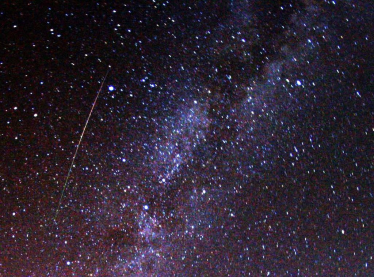A firework display is often the finale of a celebratory event, something that many people can experience and enjoy at the same time. This week, the 9 – 14th August, we should be seeing a firework display with a difference: rather than sparks shooting from the ground upwards, they will be falling downwards. And there is actually something worth celebrating up there, as comet 67P/Churyumov-Gerasimenko simultaneously reaches its closest approach to the sun.
The Perseid meteor shower, which reaches its maximum on 12 August, is an annual event in the northern hemisphere which frequently garners media attention, mainly because it occurs in the middle of the summer holiday. A story about cosmic fireworks is a sure winner for a slow news day, especially given that people may be away from city lights, and able to see the night sky more clearly than usual.
Meteors, or shooting stars, are dust particles the size of sand grains that travel through the atmosphere, about 50 miles above the Earth’s surface. They move fast – some 20-30 kilometres per second – and friction between the particle and the atmosphere at that speed causes them to heat up, emitting light. The grains aren’t burning up, they are evaporating into a plasma, which exists for a split second, before extinguishing.

Nothing lands from a meteor. And neither do they go bang like a firework – the most they might do is sizzle a little bit – but you would have to be somewhere extremely quiet to hear them. A shooting star is generally white, but they can be coloured, mainly green or orange depending on their composition. Orange is from sodium, the same colour that stains the night sky in cities, with reflected light from street lights.
On most nights of the year, around six meteors per hour can be seen, assuming the skies are clear. These sporadic meteors emanate from random bits of dust from asteroids or comets. At certain times of the year, though, the count goes up to more like 100 meteors per hour. Such meteor showers or storms are connected with specific comets, which is why we are able to predict them.
The Perseids are associated with comet Swift-Tuttle, which takes 133 years to travel around our solar system. It was last at perihelion (its closest approach to the sun) in 1995. Each time the comet comes to the inner solar system, it sheds dust. Over time, this debris has built up, and is smeared out along the entire track of the orbit. Once a year, in August, the Earth’s orbit crosses that of comet Swift-Tuttle, and dust from the comet is captured.
If you record a meteor shower, it seems as if all the tracks come from a single point – the radiant. For the Perseids, the radiant is in the constellation of Perseus, which is in the north-east part of the sky. The shooting stars aren’t coming from Perseus, they just appear to be, in the same way that the parallel tracks of a railway line appear to converge as they disappear into the distance.

All eyes on 67P
At the same time that the Perseids are lighting up the night skies, 67P reaches its perihelion – the point at which its activity is expected to be at its highest. This is a prime focus of the Rosetta mission: the spacecraft has been travelling alongside 67P for a year, observing development of the comet’s tail, how the nucleus has outgassed and where jets have formed.
Over the past few months we have been treated to amazing images of the nucleus, and the spacecraft has had to retreat further and further away from the comet as the amount of dust increased, causing a hazard to the navigation systems. I must make it clear that even though I have linked them in this column, the Perseid meteor shower is not connected with comet 67P or the Rosetta mission.

Over the coming year, Rosetta will watch as the comet moves away from the sun, causing the tail to die away and the surface to re-freeze. Then, the spacecraft will be able to get closer to the nucleus again. We should hear more from the Philae lander (assuming communications get sorted out), and see additional fantastic pictures of the comet’s rugged surface.
What we probably won’t see is a display of cometary fireworks from the Perseids. In the UK, at least, the prediction of a storm of shooting stars is almost inevitably the cue for a week of unbroken cloud. Still, if you are in the northern hemisphere, look to the north-east after midnight – and if you wish to wish upon a shooting star, I hope you manage to see at least one.
![]()
This article was originally published on The Conversation. Read the original article.

Rate and Review
Rate this article
Review this article
Log into OpenLearn to leave reviews and join in the conversation.
Article reviews